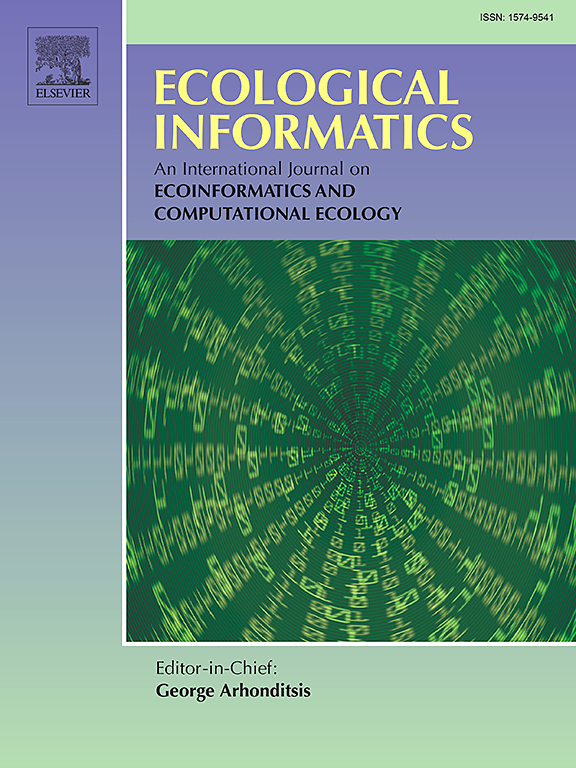结合遥感和生物地球化学模型绘制和监测土地碳汇的新方法:布基纳法索的案例研究
IF 5.8
2区 环境科学与生态学
Q1 ECOLOGY
引用次数: 0
摘要
准确和及时地估计土壤和森林生物量中的碳固存对于碳储量评估、森林退化监测和减缓气候变化等应用至关重要。传统的方法,如实地调查、遥感和生物地球化学模型,各有优点和局限性,特别是在数据匮乏的地区。为了应对这些挑战,本研究将基于光利用效率的ETLook模型(由遥感数据驱动)与生物地球化学模型DayCent(由管理和天气数据驱动)相结合,对地上生物量和碳封存进行空间模拟。这种新颖的方法旨在改善布基纳法索一个案例研究地区的碳封存估算,该地区持续的政治不稳定严重限制了实地数据的可用性。在缺乏真实数据的情况下,我们比较了DayCent和ETLook在时间和空间上的输出,以建立对我们估计的信心。研究结果表明,尽管受到不同输入数据的驱动,DayCent模型与ETLook模型观测到的地上生物量模式非常接近,r2值为0.81,KGE值为0.77,偏差低,季节性模式一致。由于ETLook缺乏土壤碳模块,将其净初级生产力(NPP)和增长估算与DayCent的土壤有机碳(SOC)输出相结合,可以提供比单独使用任何一个模型更可靠的总碳固存估算。未来的工作将侧重于将这种混合方法应用于不同的生态和地理区域,以评估其更广泛的适用性。本文章由计算机程序翻译,如有差异,请以英文原文为准。
A novel approach to mapping and monitoring land carbon sinks by combining remote sensing and biogeochemical modeling: A case study in Burkina Faso
Accurate and timely estimation of carbon sequestration in soil and forest biomass is crucial for applications such as carbon stock assessment, forest degradation monitoring, and climate change mitigation. Traditional methods such as field inventories, remote sensing, and biogeochemical models each have strengths and limitations, particularly in data-scarce regions. To address these challenges, this study integrates the light-use efficiency based ETLook model, which is driven by remotely sensed data, with the biogeochemical model DayCent, which is driven by management and weather data, to spatially model aboveground biomass and carbon sequestration. This novel approach aims to improve carbon sequestration estimates in a case study area in Burkina Faso, where ongoing political instability severely limits the availability of field data. In the absence of ground-truth data, we compare the outputs from DayCent and ETLook across time and space to build confidence in our estimates. Our findings indicate that, despite being driven by different input data, the DayCent model closely matches the aboveground biomass patterns observed in the ETLook model, with an r value of 0.81, a Kling-Gupta efficiency (KGE) of 0.77, low bias, and consistent seasonal patterns. Since ETLook lacks a soil carbon module, combining its Net Primary Productivity (NPP) and growth estimates with DayCent’s soil organic carbon (SOC) outputs provides a more robust estimate of total carbon sequestration than either model alone. Future work will focus on applying this hybrid approach across different ecological and geographical regions to evaluate its broader applicability.
求助全文
通过发布文献求助,成功后即可免费获取论文全文。
去求助
来源期刊

Ecological Informatics
环境科学-生态学
CiteScore
8.30
自引率
11.80%
发文量
346
审稿时长
46 days
期刊介绍:
The journal Ecological Informatics is devoted to the publication of high quality, peer-reviewed articles on all aspects of computational ecology, data science and biogeography. The scope of the journal takes into account the data-intensive nature of ecology, the growing capacity of information technology to access, harness and leverage complex data as well as the critical need for informing sustainable management in view of global environmental and climate change.
The nature of the journal is interdisciplinary at the crossover between ecology and informatics. It focuses on novel concepts and techniques for image- and genome-based monitoring and interpretation, sensor- and multimedia-based data acquisition, internet-based data archiving and sharing, data assimilation, modelling and prediction of ecological data.
 求助内容:
求助内容: 应助结果提醒方式:
应助结果提醒方式:


